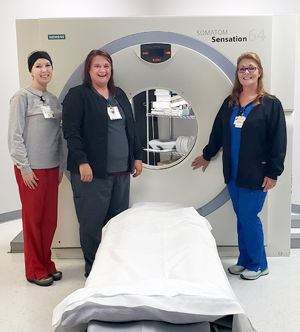BJC donates CT scanner to rural hospital
When Putnam County Memorial Hospital in Unionville, Missouri, started having issues with its CT scanner, the hospital’s CEO, Gayle Pickens, jokingly asked a colleague at Blessing Health System, part of the BJC Collaborative, “You don’t have a spare CT in your closet, do you?”
That colleague, Blessing Hospital’s purchasing director, Rachel Acuff, immediately called Larry McWhirter, BJC clinical asset management vice president, explaining the situation and noting that Putnam County Hospital didn’t have the funds to repair the scanner or invest in a new one.
Acuff called Pickens back within 15 minutes. “She said, ‘You’ll be receiving a call from Larry McWhirter of BJC HealthCare — and you need to take that call,’” Pickens says.
 McWhirter had good news for Pickens: BJC would be willing to donate a displaced CT scanner being stored at the BJC Asset Recovery Center in Fenton, Missouri.
McWhirter had good news for Pickens: BJC would be willing to donate a displaced CT scanner being stored at the BJC Asset Recovery Center in Fenton, Missouri.
“I was shocked and very humbled,” Pickens says. “With the scanner down, it was challenging to provide patient care.”
“It was hard for us and for our patients,” adds Tiffany Trent, the hospital’s radiology director. “We serve an older community, and the closest hospital with a CT scanner is 30 minutes away. We had to send patients away, and ambulances had to bypass us if patients needed a CT scan.”
McWhirter says helping other facilities with repurposed BJC equipment and supplies is actually quite common. “At BJC, we do our best to try to support these kinds of requests — locally, regionally and globally,” he says. “Whenever we can help someone in need, it’s the right thing to do.”
McWhirter told Pickens that Siemens Medical Systems would help ensure the CT scanner was delivered and properly installed and the application process was complete.
“It took several months to get prepared,” Pickens says. “Our last CT was a 16-slice scanner, and this is a 64-slice scanner. Also, our previous system was air-cooled, and this is water-cooled. So we had to reconfigure everything to get it up and running, and preparation took a while.”
The vendor representatives helped set up the room, then brought in the scanner in pieces and assembled it, did all of the system checks, got it up and running and did some trouble-shooting.
“We’ve been up and running without any issues,” Pickens says. “This has been a huge blessing to us. We’ve never had something this high-tech. And, even with installation costs, we paid half of what we would have paid for a used 16-slice scanner.”
“It provides better image quality and it’s faster, so patients don’t have to lie in the same position so long,” Trent adds.
Pickens and Trent both say everyone they came in contact with from BJC was top-notch. “They were all very professional,” Trent says. “And when we had problems, they made calls and took care of everything.”
McWhirter says it’s all part of BJC’s mission to improve the health of the communities it serves. “BJC believes in being good stewards within the medical community — regardless of where that might be,” he says. “It’s about doing the right thing for the right reasons.”
BJC clinical asset management — doing good while reducing waste
At first glance, the BJC clinical asset management (CAM) Asset Recovery Center (ARC) looks like a health care version of Home Depot. But it’s actually a carefully catalogued and labeled collection of surplus supplies and equipment from around BJC.
The ARC serves primarily as a clearinghouse, storage facility and repair shop for these goods. Rather than discarding equipment that’s no longer needed, CAM team members, with the support of vice president Larry McWhirter, work hard to make sure items are reused, repurposed, sold or donated to charity.
When equipment is replaced or supplies reach their expiration date, they often end up at the ARC. If repairs are needed, clinical engineers repair everything from telemetry equipment to televisions in the CAM repair depot.
With used equipment in good shape, the CAM team may see if another BJC facility or a member of the BJC Collaborative can use it and have it redeployed. If not, equipment might be donated to other local or regional organizations — or it might be sent halfway around the world for use in developing countries. It’s all part of CAM’s tradition of finding ways to do good while reducing waste.
“There is no revenue gain for this, and it’s an added task,” McWhirter says. “We’re able to do this because BJC allows us to do it,” McWhirter says. “That speaks highly of BJC as an organization, its leadership and its employees as a whole.”